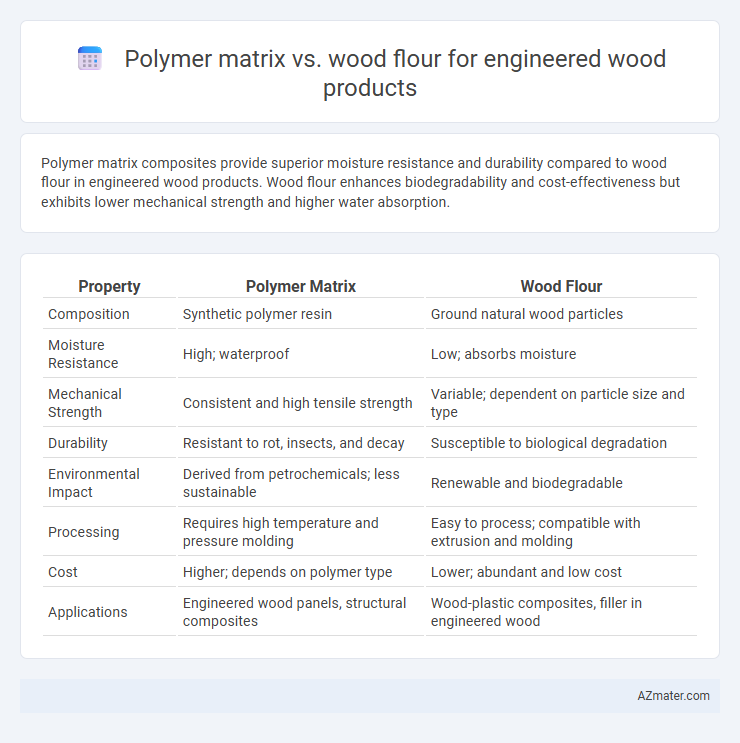Polymer matrix composites provide superior moisture resistance and durability compared to wood flour in engineered wood products. Wood flour enhances biodegradability and cost-effectiveness but exhibits lower mechanical strength and higher water absorption.
Table of Comparison
| Property | Polymer Matrix | Wood Flour |
|---|---|---|
| Composition | Synthetic polymer resin | Ground natural wood particles |
| Moisture Resistance | High; waterproof | Low; absorbs moisture |
| Mechanical Strength | Consistent and high tensile strength | Variable; dependent on particle size and type |
| Durability | Resistant to rot, insects, and decay | Susceptible to biological degradation |
| Environmental Impact | Derived from petrochemicals; less sustainable | Renewable and biodegradable |
| Processing | Requires high temperature and pressure molding | Easy to process; compatible with extrusion and molding |
| Cost | Higher; depends on polymer type | Lower; abundant and low cost |
| Applications | Engineered wood panels, structural composites | Wood-plastic composites, filler in engineered wood |
Introduction to Engineered Wood Products
Engineered wood products combine natural wood fibers with binders or polymers to create materials with enhanced strength and durability. Polymer matrix composites in engineered wood improve moisture resistance and mechanical performance compared to traditional wood flour-based composites, which are derived from finely ground wood fibers. The integration of polymer matrices enables better control of physical properties, making these composites ideal for diverse construction and manufacturing applications.
Overview of Polymer Matrix in Composites
Polymer matrix in engineered wood products serves as the continuous phase that binds wood flour particles, providing mechanical strength and resistance to moisture and decay. Common polymers used include polyethylene (PE), polypropylene (PP), and polyvinyl chloride (PVC), which enhance durability, weather resistance, and impact performance. The polymer matrix significantly improves dimensional stability and extends the lifespan of wood composite materials compared to untreated wood flour alone.
Role of Wood Flour in Engineered Wood
Wood flour enhances engineered wood products by improving mechanical strength, dimensional stability, and resistance to environmental factors. Its fine particles promote better dispersion within polymer matrices, leading to superior adhesion and composite integrity. Incorporating wood flour also boosts the sustainability of engineered wood by utilizing natural, renewable materials that reduce overall product weight and carbon footprint.
Material Properties: Polymer Matrix vs Wood Flour
Polymer matrix in engineered wood products offers superior moisture resistance, enhanced durability, and improved thermal stability compared to wood flour, which is prone to water absorption and biological degradation. Wood flour provides natural aesthetics and higher stiffness due to its lignocellulosic fibers but lacks the dimensional stability and impact resistance found in polymer matrices. Combining polymer matrices with wood flour optimizes composite performance by balancing mechanical strength and environmental resilience.
Mechanical Performance Comparison
Polymer matrix composites exhibit superior mechanical performance compared to wood flour in engineered wood products, offering higher tensile strength, impact resistance, and durability. Wood flour, while cost-effective and environmentally friendly, typically provides lower stiffness and strength, limiting its use in high-load applications. Optimizing the polymer matrix enhances flexibility and moisture resistance, making it more suitable for structural components.
Durability and Environmental Resistance
Polymer matrix composites exhibit superior durability and environmental resistance compared to wood flour-based engineered wood products due to their enhanced moisture resistance, UV stability, and resistance to biological decay. The polymer matrix effectively shields the composite from fungal attacks, rot, and insect damage, extending the product's lifespan in harsh outdoor conditions. Wood flour composites tend to absorb moisture, leading to swelling and degradation, which limits their durability and maintenance requirements in exterior applications.
Processing Techniques and Manufacturing
Polymer matrix composites in engineered wood products involve melt processing techniques like extrusion and injection molding to combine thermoplastic polymers with reinforcing fibers, enabling precise control over material properties and complex shapes. Wood flour composites utilize compression molding and extrusion, where wood flour particles are dispersed in a polymer matrix, requiring careful moisture control and temperature management to avoid degradation and ensure optimal bonding. Advanced manufacturing methods for polymer matrix composites often incorporate automated layering and additive manufacturing, whereas wood flour composites rely on traditional molding and compounding processes for cost-effective scalability.
Cost Analysis and Economic Viability
Polymer matrix composites often exhibit higher initial material costs than wood flour-based engineered wood products due to the expense of synthetic polymers and processing technologies. Wood flour, derived from wood waste, offers a cost-effective, sustainable alternative with lower raw material and production expenses, enhancing economic viability for large-scale applications. Lifecycle cost assessments favor wood flour composites in terms of recyclability and renewable resource utilization, driving long-term affordability and market competitiveness.
Sustainability and Environmental Impact
Polymer matrix composites generally have lower biodegradability compared to wood flour-based engineered wood products, leading to longer environmental persistence and challenges in disposal. Wood flour, derived from natural wood fibers, enhances the product's biodegradability and supports a circular economy by utilizing renewable biomass and reducing reliance on non-renewable polymers. The environmental impact of polymer matrix composites includes fossil fuel consumption and greenhouse gas emissions during production, whereas wood flour composites offer improved carbon sequestration and reduced ecological footprints.
Future Trends and Innovations in Engineered Wood Products
Future trends in engineered wood products emphasize the integration of polymer matrices with wood flour to enhance mechanical properties, durability, and moisture resistance, creating superior composite materials. Innovations include bio-based polymers and nanocellulose additives that improve sustainability and performance while reducing environmental impact. Research into hybrid composites aims to optimize the balance between stiffness, strength, and biodegradability for applications in construction and automotive industries.

Infographic: Polymer matrix vs Wood flour for Engineered wood product
 azmater.com
azmater.com